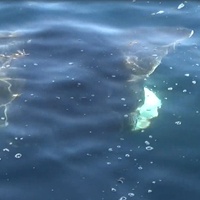Basking Shark observed off eastern Tasmania
Redmap Team, 09 Sep 2015.
Although within the known distribution for this species, observations of Basking Sharks in the wild are quite rare...
After the recent media attention surrounding the rarely-seen Basking Shark (Cetorhinus maximus) accidently caught by commercial fishers in Victorian waters and donated to Museum Victoria (the home of our very own Redmap Victoria regional representative and museum curator Dr Dianne Bray), one lucky Redmapper was lucky enough to also see a basking shark feeding off the east coast of Tasmania.
Bicheno fisherman Rodney Brill recently sent in video footage and sighting information to Redmap regarding a 6m basking shark he observed while out on his boat off the East Coast of Tasmania (see sighting HERE). This is the first time a basking shark sighting has been submitted to Redmap in Tasmania, and a previous sighting of a 7m long individual in Victoria was submitted last year.
Although within the known distribution for this species, observations of Basking Sharks in the wild are quite rare since they are usually in deeper waters, living well away from the continental shelf. Basking sharks are the second largest fish (growing up to almost 15m), are filter-feeders, are very widely distributed, and are thought to live up to around 50 years of age. They are called “basking” sharks because they tend to “bask” on the surface in good weather, and often feed on zooplankton at the surface.
These animals are listed as vulnerable within the IUCN Redlist, and are protected from fishing in many areas. This listing category suggesting the species is considered to be at high risk of extinction.
Check out this short snippet from Rodney’s video HERE!
References and further reading:
http://www.iucnredlist.org/details/4292/0
http://www.fishesofaustralia.net.au/home/species/1847
http://museumvictoria.com.au/about/media-centre/media-releases/basking-shark-caught-off-portland/
http://www.fishbase.org/summary/90
http://marinebio.org/species.asp?id=193

IMAGERY provided by Redmap volunteer Rodney Brill.












